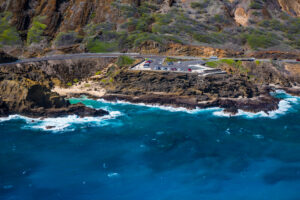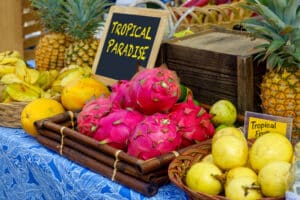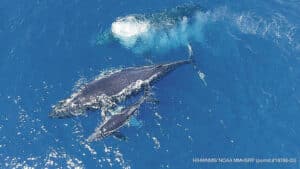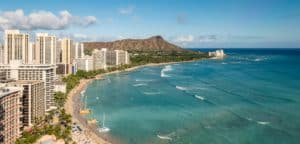This article was originally published November 8, 2015 and updated on September 3, 2025.
On the southeast coast of Oʻahu, about 10 miles east of Waikīkī, lies one of Hawaiʻi’s most beloved natural treasures: Hanauma Bay Nature Preserve. This crescent-shaped cove is not just beautiful — it’s also a living museum of marine biodiversity. Once the site of a volcanic eruption thousands of years ago, the crater eventually flooded with ocean water to become the sheltered bay we see today. Since being declared a protected Marine Life Conservation District in 1967, Hanauma Bay has welcomed millions of visitors eager to experience its vibrant reef and thriving ecosystem.
Each year, travelers from around the world flock here to snorkel among over 400 species of tropical fish, glide beside graceful green sea turtles (honu), and soak up views that look like they’re straight off a postcard. Whether you’re a first-time snorkeler or a seasoned adventurer, Hanauma Bay is one of Oʻahu’s must-do activities.
Why Hanauma Bay is Special
Unlike many other beaches on Oʻahu, Hanauma Bay is fully dedicated to marine conservation. The reef is protected, fishing is prohibited, and every visitor must watch an educational video before entering. This short film explains reef etiquette, safe snorkeling practices, and the importance of preserving this fragile ecosystem. The system works: since daily visitor numbers were capped and reservations introduced in recent years, both water clarity and marine life health have improved dramatically.
Hanauma Bay also holds cultural significance. For centuries, Native Hawaiians used the area as a place of gathering and fishing. Its name, “Hanauma,” comes from hana (bay) and uma (curve), describing its shape. Today, it serves not only as a world-class snorkeling site but also as a reminder of the deep relationship between Hawaiians and the sea.
Visiting in 2025: Hours, Reservations & Fees
-
Open: Wednesday through Sunday
-
Closed: Mondays, Tuesdays, Christmas Day, and New Year’s Day
-
Entry window: 6:45 a.m. – 1:30 p.m. (visitors must leave by 4:00 p.m.)
-
Reservations: Required for most non-resident visitors. Reservations open online two days in advance at 7:00 a.m. HST and sell out within minutes, especially during holidays and weekends.
-
Walk-in tickets: Limited and only available early morning. All group members must be present at purchase.
Entry Fees (2025):
-
$25 per non-resident (13+)
-
Free for Hawaiʻi residents (with ID), children 12 and under, and active U.S. military with ID
Parking:
-
$3 for non-residents
-
$1 for residents
-
Refundable if you exit within 15 minutes
A tram takes you from the upper parking lot to the beach, and the ride is included in admission.
Amenities and What to Bring
Hanauma Bay has everything you need for a full day at the beach: lifeguards, restrooms, showers, a snack bar, gear rentals, and a small gift shop. Still, many visitors prefer to bring their own snorkel set for comfort and hygiene. A lightweight cooler with drinks and snacks is a good idea, but alcohol and large beach setups are prohibited.
Essentials to pack:
-
Reef-safe sunscreen (Hawaiʻi bans sunscreens with oxybenzone and octinoxate)
-
Water shoes or sturdy sandals for the walk down
-
Lightweight beach towel and hat
-
Underwater camera for fish spotting
-
Cash or card for entrance fees and snacks
The Snorkeling Experience
Once you step onto the beach, you’ll see why Hanauma Bay has become world-famous. The calm, shallow lagoon makes it easy to wade in, and the reef starts just steps from shore. Beginner snorkelers can stick to waist-deep waters near the inner reef, where colorful schools of fish dart through coral heads. More confident swimmers can explore further out in the bay, where you might encounter butterflyfish, trumpetfish, and even the occasional Hawaiian monk seal resting on the sand.
Popular snorkeling zones inside Hanauma Bay include:
-
Keyhole: A sandy channel that’s perfect for beginners.
-
Sandman’s Patch: Known for bright coral formations.
-
Backdoor and The Witches Brew: For stronger swimmers only — rougher conditions with incredible fish life.
Visibility is usually excellent in the morning, before the trade winds pick up. Aim to enter the water before 10:00 a.m. for the clearest conditions.
Conservation in Action
One of the most remarkable aspects of Hanauma Bay is how it demonstrates the success of conservation. In the early 2000s, crowds of up to 10,000 daily visitors were damaging the reef. Today, thanks to strict caps of about 1,400 visitors per day, the reef has rebounded. Corals are healthier, fish populations have grown, and the bay is noticeably clearer.
This conservation model has inspired other marine parks worldwide and gives visitors a chance to actively participate in protecting Hawaiʻi’s ecosystems simply by following the rules:
-
Don’t touch or stand on coral.
-
Don’t chase or feed fish.
-
Stay at least 10 feet from turtles and monk seals.
-
Always pack out trash.
Insider Tips
-
Arrive early: Parking often fills by 7:30 a.m., although there is turnover throughout the day.
-
Check surf reports: While usually calm, strong waves or currents may appear in winter.
-
Skip the shuttle tours unless you want convenience: Independent travel is cheaper, but tours offer hotel pickup and guaranteed gear.
-
Bring snacks and water: Food inside the preserve is limited and pricey.
-
Watch for humpback whales: From December to April, you might see them breaching offshore as you exit the bay.
Final Word
If you’re planning a trip to Oʻahu, Hanauma Bay is a must-visit destination. It offers not only some of the best snorkeling in Hawaiʻi but also a lesson in how conservation and responsible tourism can revive a natural wonder. With planning, patience, and respect for the land and sea, your day at Hanauma Bay will be one of the highlights of your Hawaiian adventure.











